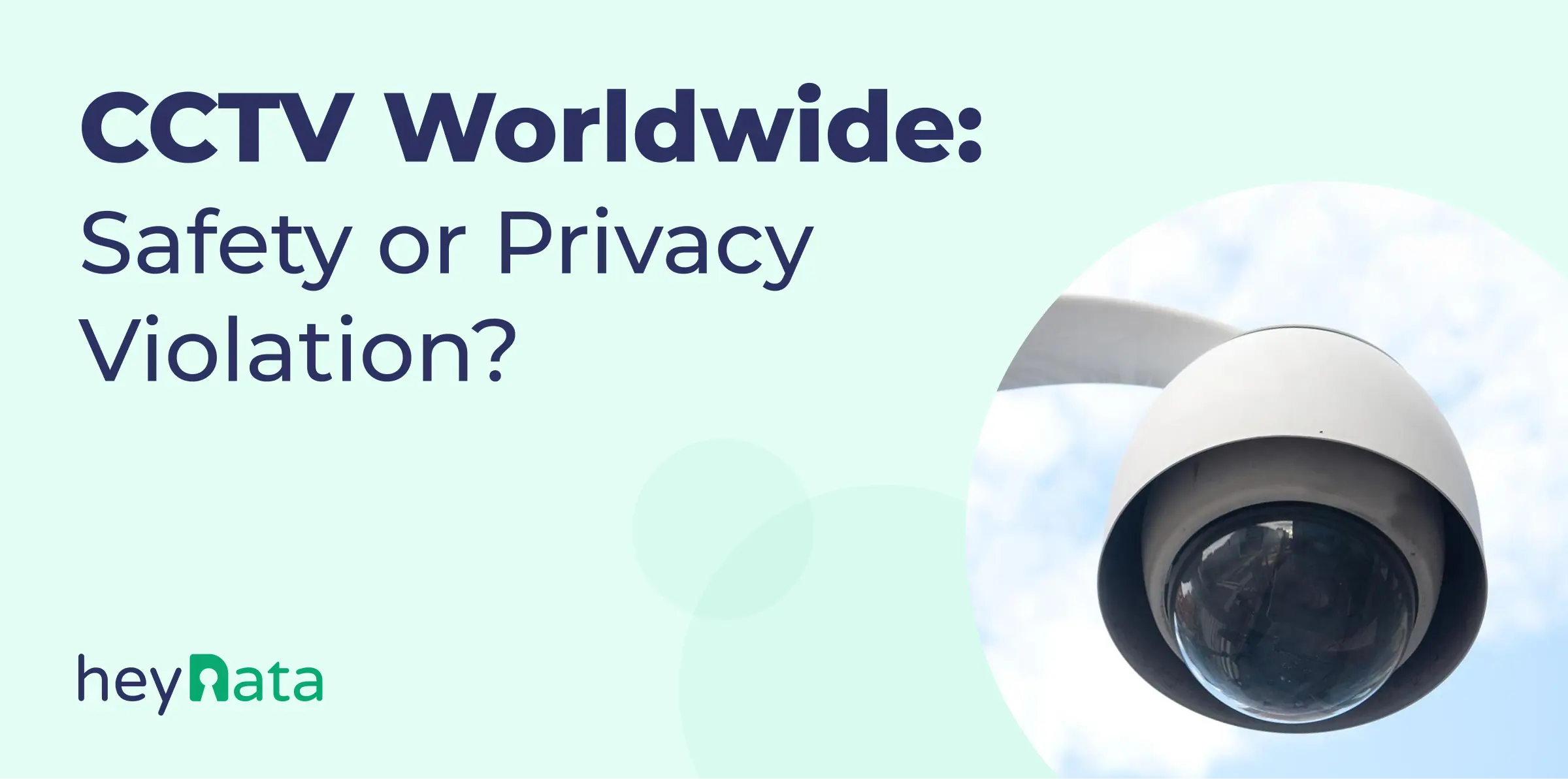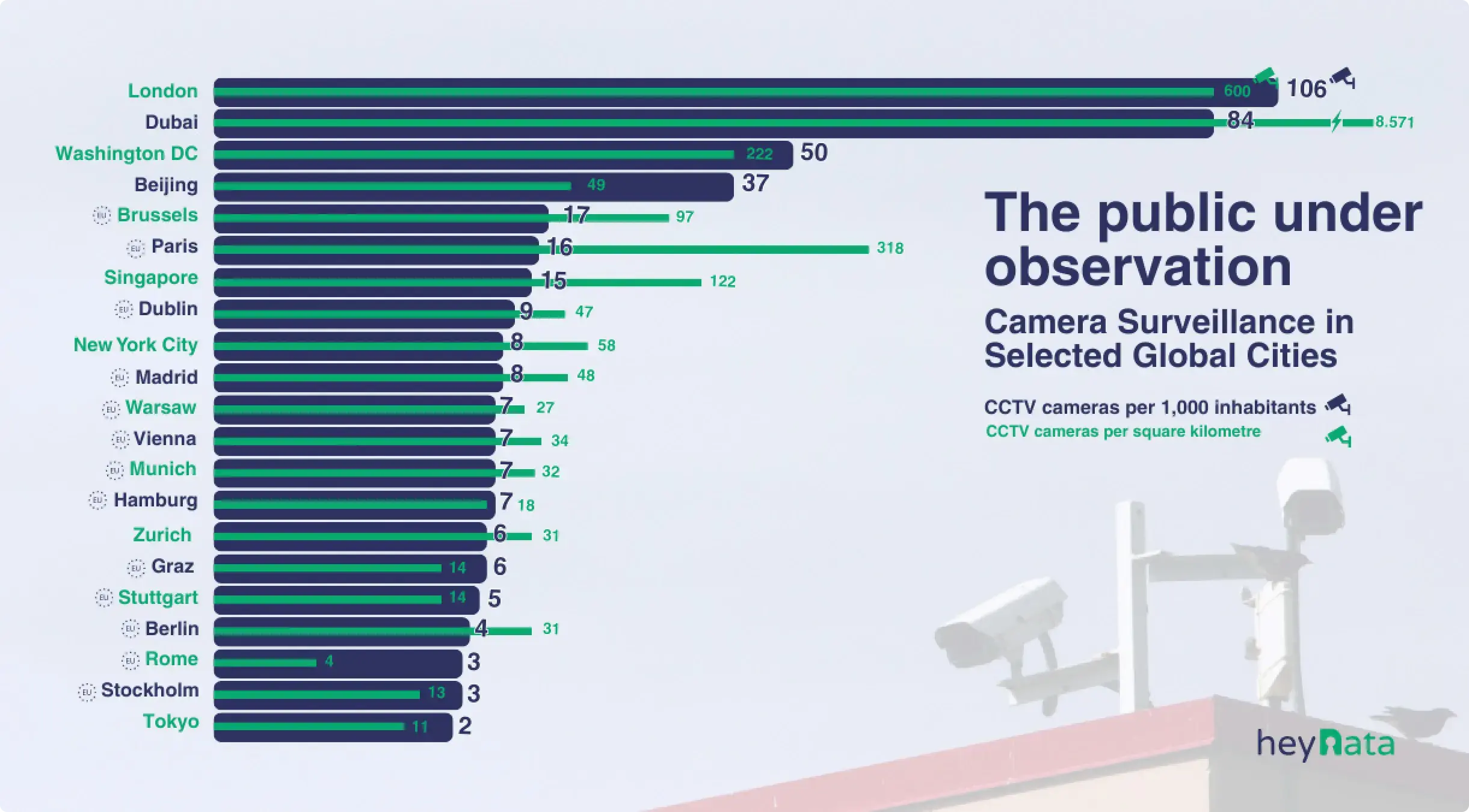
CCTV Worldwide - Between Safety and Civil Liberties

From bustling city centers to crowded commuter hubs and large public events, video surveillance has become a key tool in crime prevention, counterterrorism, and crowd control worldwide. But every surveillance camera also collects personal data, raising an essential question:
Where should we draw the line between legitimate security interests and our right to privacy?
Cameras, Control, and Controversy: A Global Look at 21 Cities
An analysis of 21 major cities around the world shows just how widely the use of public surveillance cameras varies. The study includes global metropolises like New York City, Dubai, and Beijing, as well as German-speaking cities such as Berlin, Hamburg, Munich, Stuttgart, Zurich, Vienna, and Graz.
The data reveals stark contrasts - not just in the number of cameras per capita, but also in how densely they are deployed across urban space.

London: The Surveillance Capital of Europe
With roughly one million cameras, London has one of the most expansive surveillance networks in the world - averaging about 106 cameras per 1,000 residents. The primary aim is crime prevention and rapid response. However, such a dense network raises serious concerns about personal freedom, especially when paired with advanced technologies like facial recognition.
Dubai: Every Square Meter Under Watch
Dubai tops the list in terms of camera density, with over 8,500 cameras per square kilometer. Thanks to the city’s compact size and strict governance, nearly every public space is monitored. While intended to enhance security, this level of control comes with significant privacy implications, especially in a country with limited legal safeguards for personal data.
Paris: Caught Between Security and Surveillance
Following a series of terror attacks, Paris dramatically increased its surveillance infrastructure. The city now averages 318 cameras per square kilometer, focusing on government districts, train stations, and tourist hotspots. Yet, many of these cameras are now also found in everyday neighborhoods, prompting ongoing debates in France about how to balance national security with individual privacy rights.
Germany: A Culture of Data Restraint
Surveillance in German cities remains relatively limited. Berlin, for example, has just 4 cameras per 1,000 people - 27 times fewer than Paris. Hamburg and Munich report 7 per 1,000; Stuttgart just 5. These numbers reflect a strong public sensitivity to privacy, deeply rooted in Germany’s historical experience with state surveillance. Still, discussions about expanding surveillance - particularly in busy transit hubs and airports - are gaining traction.
Vienna, Graz, and Zurich: Cautious Implementation
Cities like Vienna, Graz, and Zurich also maintain a conservative approach to surveillance. Vienna has around 34 cameras per square kilometer, totaling just over 14,000 public surveillance units. Graz is even more modest, with only 14 per km², while Zurich deploys about 2,700 cameras citywide - equal to 31 per km² or 6 per 1,000 residents.
These figures reflect a broader skepticism across Central Europe toward mass surveillance. Yet even here, calls for more surveillance - especially in high-traffic zones and tourist areas - are growing louder, often justified by public safety concerns.
Beijing: Surveillance as State Policy
Beijing is home to an estimated 800,000 public surveillance cameras, or 37 per 1,000 residents. While less dense than London, China’s approach is far more intrusive. Increasingly, these cameras are powered by AI, used to build behavioral profiles and track individual movements - creating a system of total surveillance that deeply encroaches on personal privacy.
The European Union: Privacy Meets Practicality
European cities, on average, show a lower reliance on surveillance than cities in other parts of the world. Even in Brussels - the EU’s capital - camera use per capita is relatively modest. Across the EU, cities average about 8 cameras per 1,000 residents and 54 per square kilometer.
This restraint reflects Europe’s strong privacy culture and regulatory protections. However, debates about expanding surveillance persist, especially for public events, critical infrastructure, and demonstrations. These debates highlight a crucial question: How much surveillance can a free society tolerate before it becomes a threat to liberty?
What Drives These Differences?
So why do some cities go all-in on surveillance while others hold back? The answer often lies in a mix of legal frameworks, technological access, political culture, and historical context.
The Legal Landscape: How Privacy Laws Shape Surveillance
European Union
In the EU, the General Data Protection Regulation (GDPR) and national laws govern how and when video surveillance can occur. Key principles like proportionality, purpose limitation, and transparency aim to ensure that personal data is used only when necessary, and with respect for individual rights.
Still, practices vary. France, for instance, embraces surveillance more broadly than Germany, where deployments face stricter requirements, reflecting Germany’s cautious approach rooted in historical memory.
Emerging technologies like facial recognition and smart video analytics raise new concerns. These tools can identify individuals or infer behavior without consent, threatening core rights like freedom of movement and non-discrimination. Since biometric data is considered highly sensitive under the GDPR, its use in public surveillance is heavily restricted and increasingly contested by data protection advocates.
United Kingdom
Post-Brexit Britain follows the Data Protection Act 2018, which mirrors many GDPR principles. However, UK law allows more extensive surveillance in public spaces when justified by security concerns—making London one of the world’s most heavily monitored cities.
United States
The U.S. lacks a single, comprehensive federal privacy law. Surveillance rules differ by state, and public spaces often enjoy minimal protection from monitoring. This patchwork legal system makes it easier to install and operate large-scale camera networks.
United Arab Emirates
In Dubai, legal protections for personal data are minimal. Surveillance is broadly used not only for safety but also for monitoring public behavior. Even casual photography in public can be tightly regulated, particularly if government buildings or individuals are inadvertently captured.
China
In China, surveillance extends far beyond crime prevention. It's a state tool for political oversight, powered by AI to recognize faces, track movements, and assess "social behavior." From a European privacy perspective, this is among the most invasive systems globally, posing profound risks to civil liberties.
The Tech Behind the Lens: Smarter, Riskier, and More Pervasive
Modern surveillance systems don’t just record footage—they interpret it. Facial recognition can identify people even in crowds. Artificial intelligence can analyze movement patterns and infer behavior, preferences, or routines.
When public and private camera networks are interconnected, they form a dense, opaque web of monitoring. This raises the risk of false positives, wrongful suspicion, and a loss of control over who accesses sensitive data. The implications are serious: mass surveillance, algorithmic bias, and an erosion of personal freedom.
How Surveillance Shapes Behavior
Surveillance doesn’t just monitor behavior - it changes it. The constant awareness of being watched can create psychological pressure, leading people to modify how they act in public. This “chilling effect” often results in self-censorship or constrained behavior.
Even worse, automated systems like facial recognition have been shown to misidentify minority groups at disproportionately high rates (NISTIR 8280, 2019), reinforcing discrimination and inequality.
Freedom or Fear? Why the Debate Matters
Video surveillance is here to stay. But how we deploy and regulate it will determine whether it safeguards our rights, or chips away at them.
The public discourse must remain grounded in facts, centered on rights, and driven by transparency. Only then can we ensure that in the digital age, freedom doesn’t become a privilege for the few, but a right for all.
Methodology & Sources
CCTV (Closed-Circuit Television) in this study refers exclusively to publicly owned and operated surveillance systems—run by governments, police forces, or public transit authorities. These systems are primarily used for real-time monitoring of public areas, crime prevention, traffic control, and maintaining order at large events. Recordings also serve investigative purposes for law enforcement.
Cameras per capita: Number of cameras relative to the city population. This metric indicates how likely individuals are to be monitored.
Cameras per square kilometer: This reflects how saturated the public space is with surveillance equipment in a given geographic area.
Sources
Dubai - Mordor Intelligence
London - Clarion UK
Paris - WorldAtlas
Washington D.C. - Comparitech
Singapore - Security Magazine / Reuters, Reuters
Brussels - Brussels Times
New York City - Comparitech
Beijing - Security Magazine
Madrid - WorldAtlas
Dublin - Irish Times
Vienna - BatchGeo
Munich - Abendzeitung München
Berlin - rbb
Zurich - GIT Sicherheit
Warsaw - Government of Sweden
Hamburg - Die Zeit
Stuttgart - Stuttgarter Nachrichten
Graz - MeinBezirk
Stockholm - BatchGeo
Tokyo - BatchGeo
Rome - Edgelands Institute


